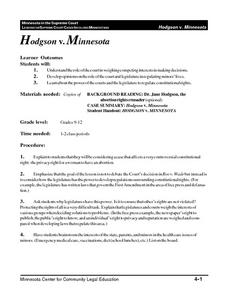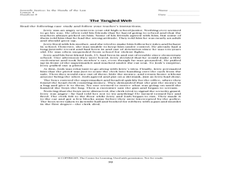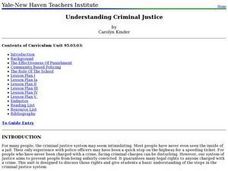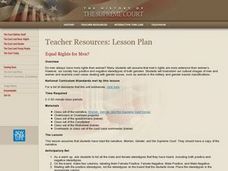Curated OER
Indiana Courts: How Do They Work?
Students identify the branches of Indiana's judicial system and determine the differences between the different courts and different types of cases. Students create a flow chart showing how a court case works its way through the legal...
Curated OER
Due Process Freedoms
Students participate in a simulation of the voir dire portion of a trial. There are student lawyers assigned for the prosecution and the defense. They must review and question all prospective jurors to obtain a fair and impartial jury.
Curated OER
Science in the Court Room
Share their opinions on the use of DNA databases in criminal investigations. After reading an article, they evaluate the pros and cons of the databases and work in groups to answer discussion questions. They write a letter to a state...
BBC
Crime
Crime and punishment! Learners discuss the law, civics, and crime in the UK. They brainstorm lists of crimes and possible punishments, complete activities on a website, role-play a Juvenile Court scenario, and try to think of ways they...
Curated OER
Hodgson v. Minnesota
Students investigate the role of and develop opinions of the court in weighing competing interests in making decisions. They examine the power of the courts and legislature to regulate constitutional rights.
Curated OER
Justice
Students discuss strengths and weaknesses of the court system in providing equal justice for all. They identify factors that cause these weaknesses and recommend solutions.
Curated OER
Consequences
Pupils identify and describe what consequences are and how they affect others. Then they play the "Kids' Court" game as a class as outlined in the lesson. Students also identify how consequences and their actions are linked using their...
Curated OER
Symbolic Speech
Ninth graders consider the right of freedom of speech as it is outlined in the U.S. Constitution. They receive background information for the US Supreme Court, the Bill of Rights, and free speech. They discuss a series of actual cases...
Curated OER
Laws...Who Needs Them?
Who needs laws? Junior high schoolers sure do! Provide your 7th-9th graders with an understandng about why laws are important and how they are used to create a functioning society. Learners use a series of handouts and readings to build...
Curated OER
Role Playing Free Speech
Students conduct research into looking at a free-speech issue. They role play the events surrounding a court case. The lesson includes guiding questions to help create context and determine areas of further study. The presentation...
Curated OER
Digital Forensics
Learners examine a crime scene and photograph evidence. In this forensics digital photography lesson, students recognize the correct procedures for filming a crime scene. Learners document evidence and keep a log of the...
Curated OER
Public Trust and Confidence
Students analyze the judiciary system. For this government lesson, students participate in a class discussion on methods to prevent unfairness in the Judicial courts.
Curated OER
On Trial - Juvenile or Adult?
Students compare and contrast juvenile and adult courts in the United States. In this judicial system lesson, students read and discuss articles and statistics in order to determine why juveniles may be tried as adults and examine the...
Curated OER
Deadlock on Verdict
Students read a text about a murder trial. They review related vocabulary, complete a matching exercise and take a quiz. Afterward, they play a game called 'alibi' where the group with the weakest alibi is found guilty.
Curated OER
Black Skin, White Justice: Race Matters in the Criminal Justice System
Students examine the effects of race in the criminal justice system. As a class, they brainstorm a list of instances when the offender has been an African American and he is not treated fairly in court based on his race. They analyze...
Curated OER
You and the Law -- Beating the Odds
Middle schoolers examine the rate of institutional racism in the United States. Individually, they write in their journals about how they can make better choices and increase their self-esteem. Using historical documents, they identify...
Curated OER
Understanding Criminal Justice
Young scholars realize that clear values are a resource of behavior in clarifying needs and wants. They clarify feelings and wants and verbalize ways in which they give up freedom and control in their lives by relinquishing decisions...
Curated OER
Judges in the Classroom
Students define the legal meaning of juvenile and identify various ways to treat young offenders. They identify the current philosophy of the Utah juvenile justice system using a true/false worksheet and discussion format.
Curated OER
The Jury's Still Out
Students examine the trials and executions of Nicola Sacco and Bartolomeo Vanzetti. In groups, they use the internet to research the impact of the executions in the shape of political cartoons and writings. They discuss an article to...
Curated OER
Mock Trial
Students rewrite a traditional fairy tale to represent the viewpoint of the villain. They participate in a mock trial of that villain in which all regular court participants (judge, jury, defendant, witnesses, plaintiff, etc) play roles.
Curated OER
Crime and Justice
Students investigate what happens when someone is arrested. They engage in a mock trial role play about a burglary. They engage in the process of the Criminal Justice System from arrest to sentencing.
Curated OER
Government Lesson Plan: Lesson Plan 9
Students examine and compare/contrast the steps of criminal and civil cases. They define key vocabulary terms, develop an outline of a criminal and civil trial, and analyze the differences in standards of proof in legal cases.
Curated OER
Adult Criminal Justice System
Twelfth graders examine the procedures and protections involved in processing an accused person through the criminal justice system. They view a Powerpoint presentation, conduct research, and write a paper describing a crime they have...
Curated OER
Equal Rights for Men?
Study the issue of gender bias in court cases with a resource that ponders the extent of gender equality. Learners examine cultural images of men and women and examine court cases dealing issues such as women in the military.

























